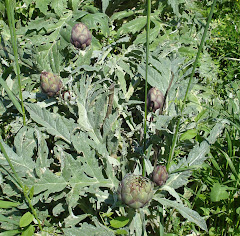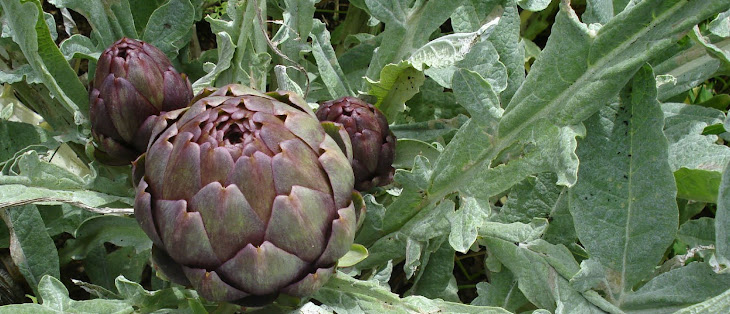 We've had an unusual amount of rain here in the past week - three whole days and nights. It's very welcome, filling the reservoirs, garden water butts and most importantly topping up the water table which is under stress due to global warming and a rapidly increasing population. The Languedoc is the area of France with the fastest growing population and even a small rural village like Gabian isn't immune to these changes. From the point of view of water the problem seems to be that many of the incomers (as well as some local people) want to have lawns in their gardens - which will need a huge amount of watering for most of the year - as well as swimming pools. Holidaymakers want golf courses, which are equally unsuitable in this climate. It's a different way of life from that of the inhabitants of small village houses with their more modest needs. There are plans to build nearly 100 houses on land next to the gardens ... we hope that this won't have too disastrous a long-term effect on the water table.
We've had an unusual amount of rain here in the past week - three whole days and nights. It's very welcome, filling the reservoirs, garden water butts and most importantly topping up the water table which is under stress due to global warming and a rapidly increasing population. The Languedoc is the area of France with the fastest growing population and even a small rural village like Gabian isn't immune to these changes. From the point of view of water the problem seems to be that many of the incomers (as well as some local people) want to have lawns in their gardens - which will need a huge amount of watering for most of the year - as well as swimming pools. Holidaymakers want golf courses, which are equally unsuitable in this climate. It's a different way of life from that of the inhabitants of small village houses with their more modest needs. There are plans to build nearly 100 houses on land next to the gardens ... we hope that this won't have too disastrous a long-term effect on the water table.
 In Vailhan, a small village nearby, they still use the old irrigation system for their very neat gardens. A central reservoir overflows through pipes and ditches to the gardens and metal gates in the channels can be moved across to divert the water from one plot to another.
In Vailhan, a small village nearby, they still use the old irrigation system for their very neat gardens. A central reservoir overflows through pipes and ditches to the gardens and metal gates in the channels can be moved across to divert the water from one plot to another.

The water course along the path through the gardens at Vailhan.
Metal gate which can be moved to divert water along another channel.
In Gabian we have an informal version of this, with a stream flowing down from the spring at the top of the hill, the Resclauze, and gardeners using hosepipes to take water to their plots. For the last few years this stream has dried up completely for months on end and we've had to rely on the metered mains water. Recently the water has started flowing again (see the picture at the top of this post), so we hope it will continue through the summer this year.

Shelves... what have these to do with the garden?
In the garden we're always conscious of water use and future shortages. Our new shelves for the study arrived this week and we're pleased that the loose-fill packaging which Vitsoe (www.vitsoe.com) used in the cartons is compostable and seems to soak up and hold a lot of water. I've put some of it straight in to trenches I've dug for broad beans and peas, watered it well and mixed it with manure, then put the soil back on top. The rest of the packaging will go on the compost heap.

This is the second sowing of broad beans and peas - the beans I sowed in November are already flowering, I was surprised to see.
We've also unwrapped our palm tree from its winter protection. Since November we've been protecting the growing point in the centre from sub-zero temperatures as it was its first winter in the ground. Its leaves unfurled slowly in the sunlight and it now looks almost back to normal, with new leaves growing well. We haven't had many frosty nights this year. If there's any more cold weather forecast we'll wrap it up again, but it seems as though winter is over now.
Palm leaf


and the radicchio which has given us salads all winter.
All the blossom seems very early this year. The almond is always the first and that's over now. Our nectarine and apricot trees are in flower already - the apricot a month earlier than a couple of years ago. One of the worries when they flower this early is that there won't be enough insects to fertilise them, but this bee seems to be doing what it should.

Now we just hope that we don't get any strong winds - last year we lost a lot of small fruits that way.
 We
We In Vailhan, a small village nearby, they still use the old irrigation system for their very neat gardens. A central reservoir overflows through pipes and ditches to the gardens and metal gates in the channels can be moved across to divert the water from one plot to another.
In Vailhan, a small village nearby, they still use the old irrigation system for their very neat gardens. A central reservoir overflows through pipes and ditches to the gardens and metal gates in the channels can be moved across to divert the water from one plot to another. 


 Now we just hope that we don't get any strong winds - last year we lost a lot of small fruits that way.
Now we just hope that we don't get any strong winds - last year we lost a lot of small fruits that way.










2 comments:
Bonsoir mme chaiselongue, it is very interesting about water. very good. JM
Merci JM. It's an important issue - I'm sure I'll be writing a lot about it! chaiselongue
Post a Comment